The previous generation’s Radeon RX 6600 offered an excellent 1080p price-to-performance ratio, generating excitement among gamers for the RX 7600. To assess its performance relative to expectations, we’ll compare the RX 7600 vs RX 6600.
Key Takeaways
- The RX 7600 was about 27% ahead of the RX 6600 in terms of average framerate.
- The RX 6600 was about 30% less power-hungry than the RX 7600.
- The difference in temperature between these cards is about 12%, favoring the RX 6600.
RX 6600 Vs RX 7600
Comparison Table
| Name | AMD RX 6600 | AMD RX 7600 |
| Architecture | RDNA 2.0 | RDNA 3.0 |
| CUDA Cores/Stream Processors | 1792 | 2048 |
| Memory Clock | 14 Gbps | 18 Gbps |
| Memory Bandwidth | 224 GB/s | 288 GB/s |
| RT Cores | 28 | 32 |
| Tensor Cores/Compute Units | N/A | 32 |
| Transistors | 11.06 billion | 13.3 billion |
| TDP | 132W | 165W |
| Power Connector | 1 x 8 pin | 1 x 8 pin |
| Launch Year | October 13, 2021 | May 24, 2023 |
| MSRP | $329 | $269 |
Architecture
- Process Size: The AMD RX 6600 is built on a 7nm process node, while the AMD RX 7600 utilizes a more advanced 6nm process node.
- Clock Speeds: The AMD RX 6600 has a base clock of 1626MHz, which can boost up to 2491MHz. On the other hand, the AMD RX 7600 has a slightly higher base clock of 1720MHz, with a boost clock reaching up to 2250MHz.
- VRAM: Both graphics cards offer 8GB of memory.
- TDP and Power Connector: The AMD RX 6600 has a TDP (thermal design power) of 132W and requires a single 8-pin power connector. In comparison, the AMD RX 7600 has a slightly higher TDP of 165W and also requires a single 8-pin power connector.
- Bus Width: Both the RX 6600 and RX 7600 have a bus width of 128-bit.
Gaming Benchmarks
This comparison section will focus on the performance difference between these GPUs in modern titles. These tests will be comprised of both demanding and easy-to-run games.
The contents of this test were taken from our test bench, swapping out the cards for each game, the specifications of which are written below:
- OS: Windows 11
- CPU: Intel Core i7 13700k
- Motherboards: MSI MEG Z790 ACE MAX
- RAM: G.Skill Trident Z5 RGB 32GB DDR5-6600 CL34 Kit
- SSD: XPG Gammix S70 BLADE 2TB NVMe
- PSU: Enermax Revolution D.F. X 1050W
- CPU Cooler: Arctic Liquid Freezer II 360
These tests were done on the 1080p resolution.
The Last Of Us
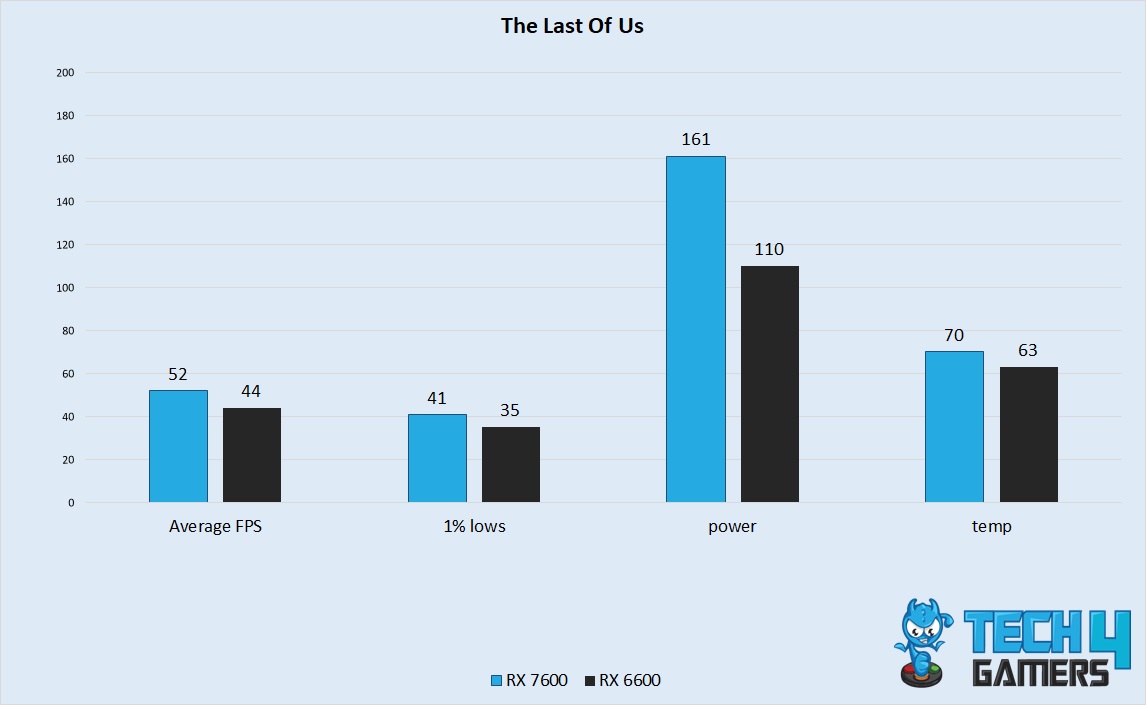
- In the first game of our testing, the RX 6600 and the RX 7600 had disappointing results. The RX 7600 averaged 52 FPS, whereas the RX 6600 averaged 44 FPS.
- The RX 7600 had higher 1% lows in this game, maintaining 41 FPS, whereas the RX 6600 XT struggled to maintain 35 FPS. Both of these 1% lows indicate stuttery performance.
- The higher power needs of the RX 7600 were confirmed in this test. The RX 7600 pulled 161 watts from the wall, whereas the RX 6600 had a power intake of 110 watts.
- Regarding temperatures, the RX 7600 reached a peak temperature of 70°C, considerably higher than the RX 6600’s peak temperature of 63°C.
Also Read: RTX 4060 Ti Vs RX 6600
Hogwarts Legacy
- Our run of Hogwarts Legacy brought both cards to their limits. The RX 7600 had an average framerate of 75 FPS in this game, whereas the RX 6600 had an average framerate of 61 FPS.
- The dips we experienced in this game were very detrimental to the gaming experience. The RX 7600 had 1% lows of 31 FPS, whereas the RX 6600 had 1% lows of about 33 FPS. The lower 1% lows of the 7600 do not indicate it being weaker than the 6600. Instead, it indicates the poor optimization of this game.
- In terms of power consumption, the RX 7600 required 181 watts, while the RX 6600 operated with a significantly lower power draw of 101 watts, proving the power efficiency of the 6600 once again.
- Regarding temperatures, the RX 7600 reached a peak temperature of 70°C, once again significantly higher than the RX 6600’s peak temperature of 62°C.
Related: RTX 3050 Vs RX 6600
God Of War
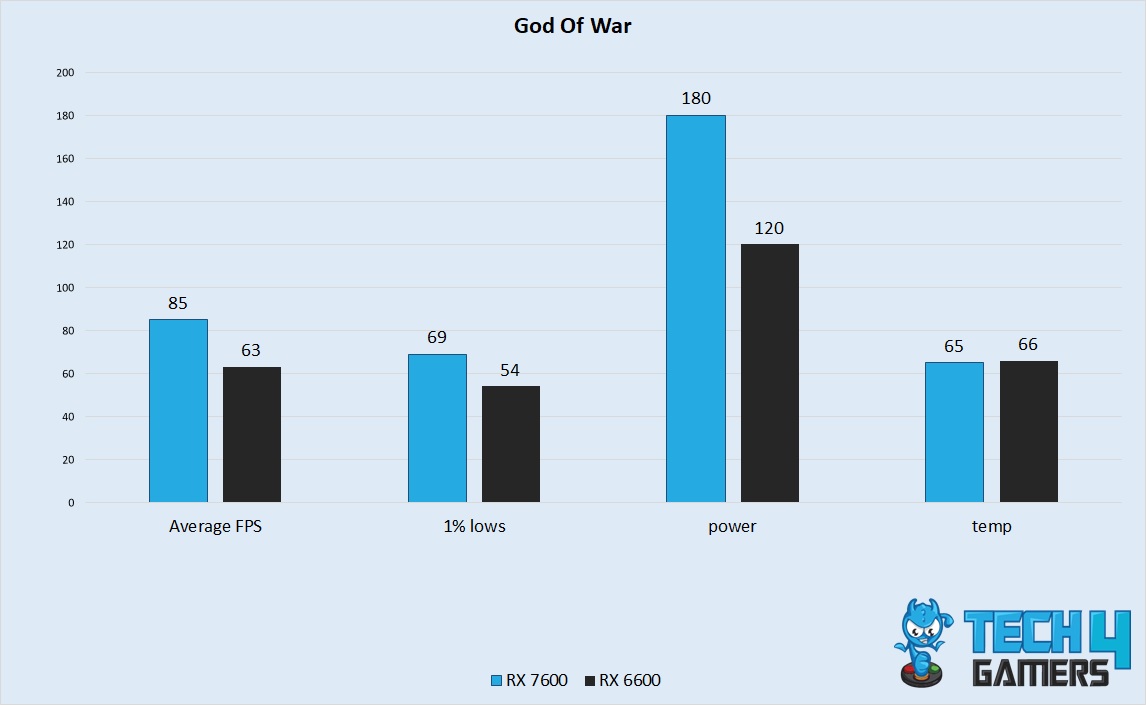
- Coming to a game that seems to make good use of the RX 7600’s more capable hardware, our run of God Of War ran much better on the newer card. The RX 7600 averaged 85 FPS, much ahead the 63 FPS given by the 6600.
- 1% lows were also a testimony to the capabilities of the 7600, with it maintaining 69 FPS, whereas the RX 6600 had 1% lows of about 54 FPS.
- Both cards continued to consume varying amounts of power. The RX 7600 required 180 watts, while the RX 6600 operated with a significantly lower power draw of 120 watts.
- Regarding temperatures, the RX 7600 reached a peak temperature of 65°C, similar to the RX 6600’s peak temperature of 66°C.
Also Read: RX 6600 Vs RTX 2060
Red Dead Redemption 2
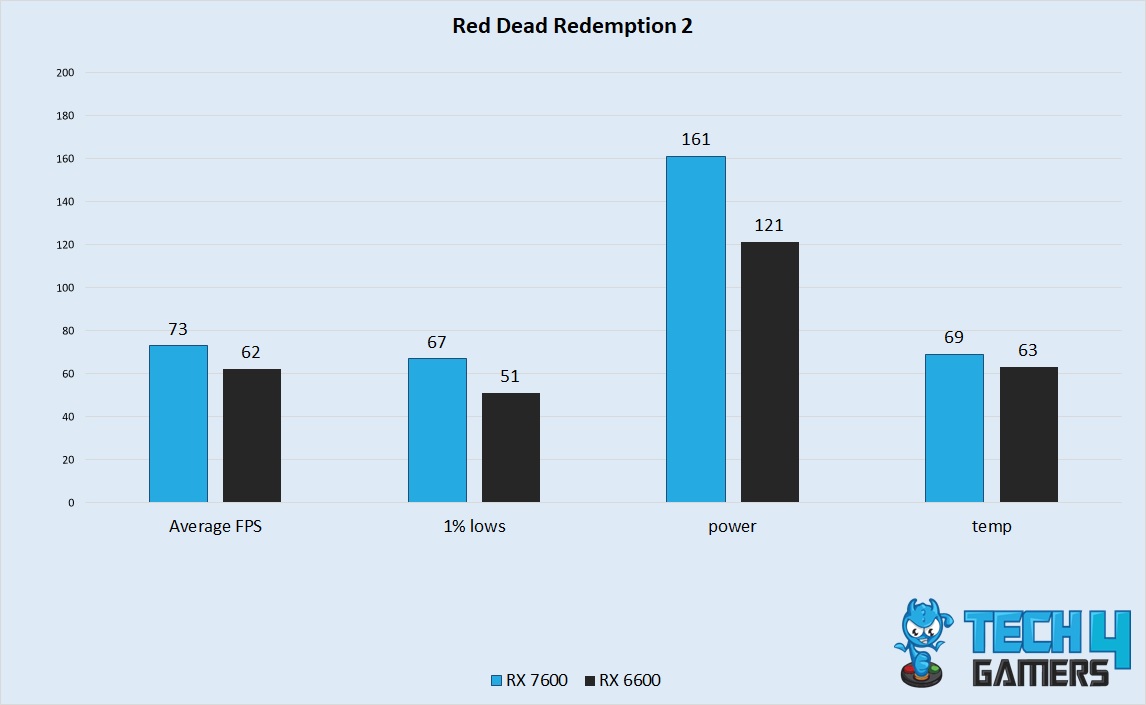
- The RX 7600 achieved a higher average of 73 FPS, outperforming the RX 6600’s average of 62 FPS in our testing of Red Dead Redemption 2.
- The RX 7600 had 1% lows of about 67 FPS, whereas the RX 6600 got down to around 51 FPS in the more demanding parts of our benchmark run.
- Regarding power consumption, the RX 7600 consumed 161 watts, whereas the RX 6600 had a power draw of 121 watts.
- The RX 7600 had a temperature of 69°C, significantly hotter than the 63°C on the RX 6600.
More From RX 7600: RX 7600 Vs RTX 3060 Ti
Shadow Of The Tomb Raider
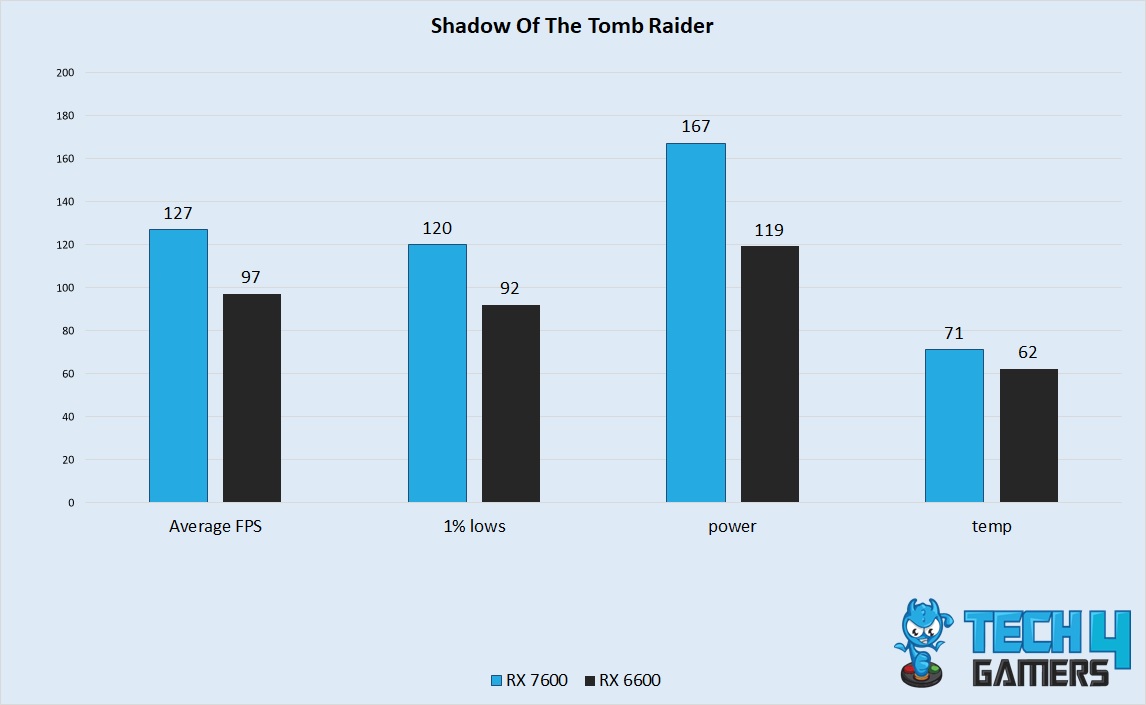
- Running The Shadow Of The Tomb Raider on our test bench with each card had both cards performing quite well. The RX 7600 manages an average of 127 FPS, whereas the RX 6600 has an average of 97 FPS.
- 1% lows were also excellent in this game, deviating very little from the average numbers. This made the game feel much smoother than most others in our testing. The RX 7600 had 1% lows of 120 FPS, whereas the RX 6600 had 1% lows of about 92 FPS.
- The RX 7600 proved to be more power-hungry at peak, with a consumption of 167 watts, whereas the RX 6600 maxed out at 119 watts.
- The temperatures were again substantially higher on the newer card, going up to 71°C, while the RX 6600 stayed relatively cool at 62°C.
The Witcher 3 Next Gen
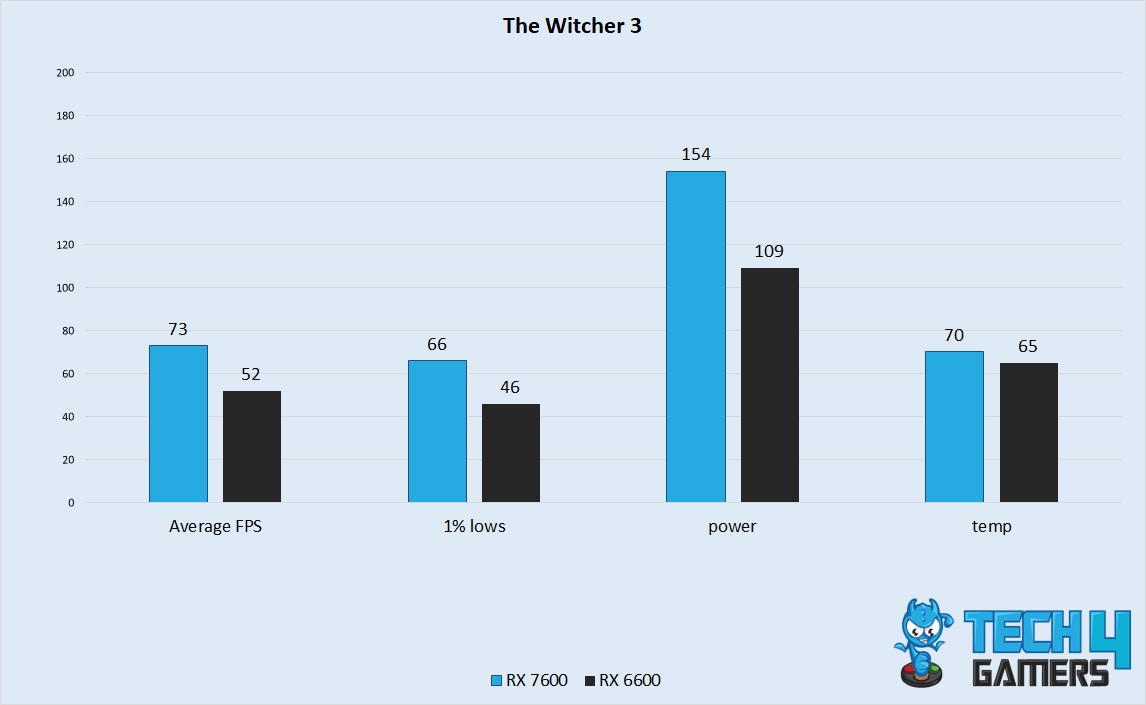
- Our test of The Witcher 3 remake ran much better on the newer card. The RX 7600 had an average of 73 FPS, whereas the RX 6600 had an average of 52 FPS. The performance of this game on the 6600 is disappointing, to say the least.
- 1% lows were also better on the newer card, with the RX 7600 maintaining lows of 66 FPS, whereas the RX 6600 had lows of 46 FPS.
- Switching gears to power consumption, the RX 7600 consumed 154 watts at peak in this game, whereas the RX 6600 maxed out at 109 watts.
- Peak temperatures were much higher on the 7600 still, reaching 70°C, whereas the 6600 had a peak temperature of 65°C.
Also Read: RX 7600 Vs RX 6650 XT
F1 22
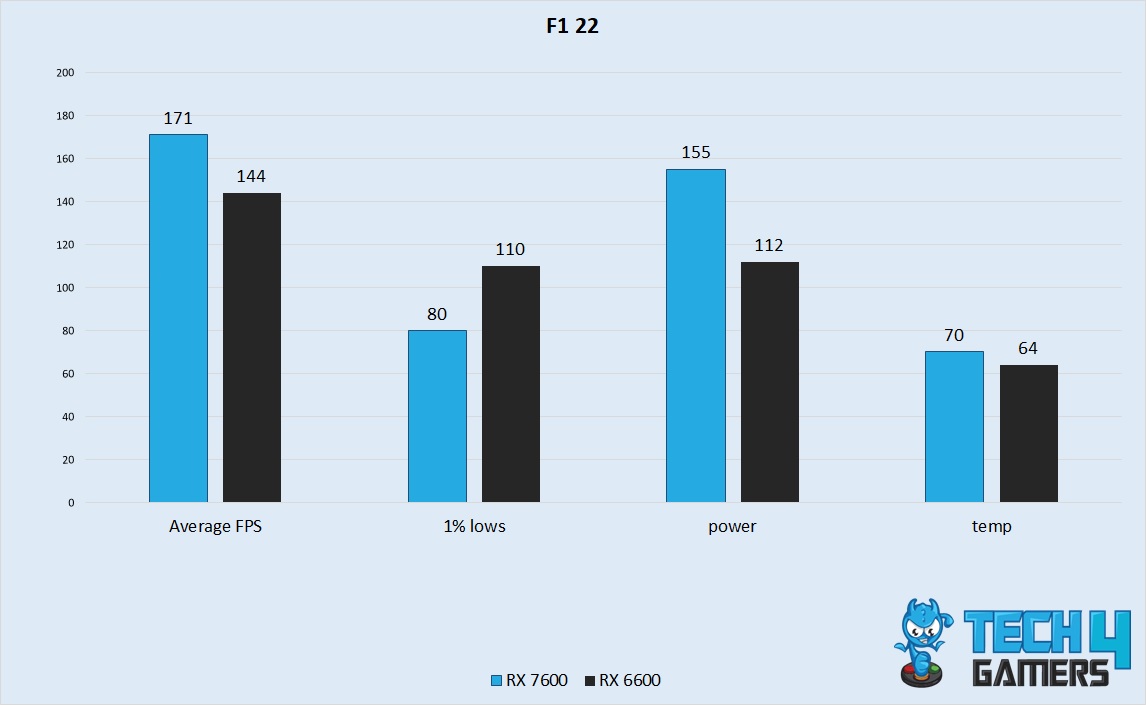
- When we ran F1 22, a game that does not have very high hardware demands, we were pleased by the results on both cards. The RX 7600 had an average framerate of 171 FPS, whereas the RX 6600 averaged 144 FPS.
- The 1% lows in this game came as a surprise to us. The RX 7600 had lower 1% lows of 80 FPS, despite having a higher average FPS, whereas the RX 6600 had 1% lows of 110 FPS, despite having lower averages.
- The power consumption was once again significantly greater on the 7600 at 155 watts, whereas the RX 6600 had a power consumption of 112 watts.
- Peak temperatures were much higher on the 7600 still, reaching 70°C, whereas the 6600 had a peak temperature of 64°C.
Also Read: RX 7600 Vs RTX 2060 Super
Forza Horizon 5
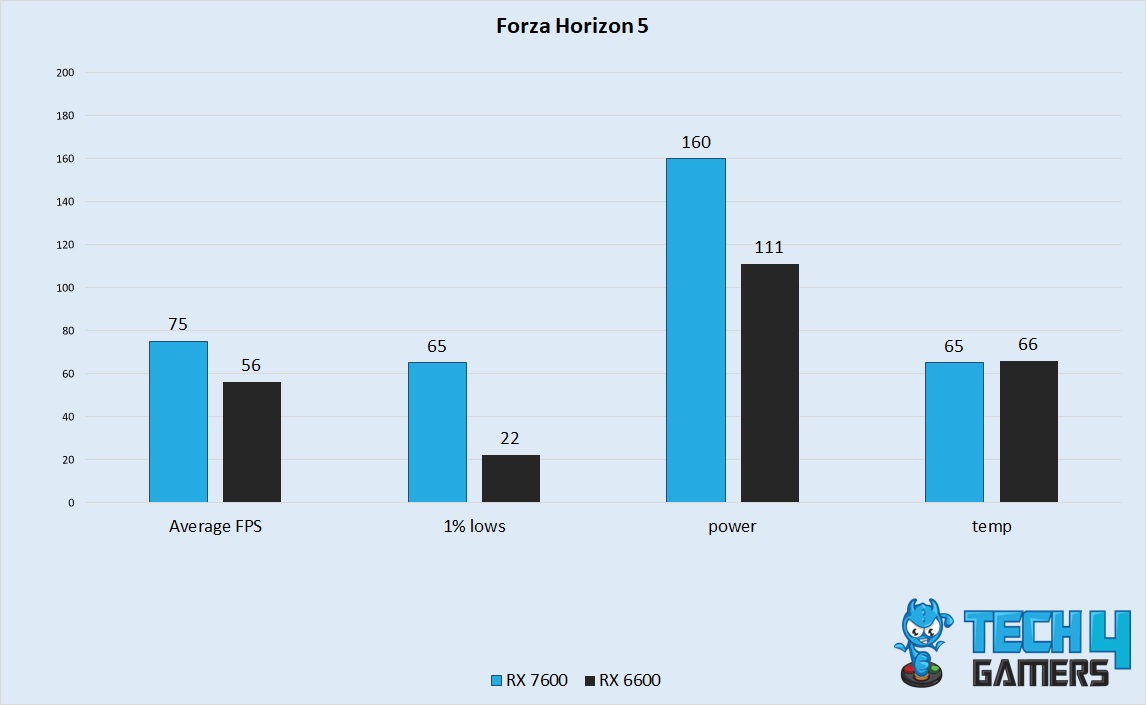
- Running another racing game on the highest graphics preset, the RX 6600 did not perform as well as we expected. It averaged 56 FPS, whereas the RX 7600 was slightly ahead with an average of 75 FPS.
- The 7600 maintained its composure in 1% lows, maintaining 65 FPS, whereas the RX 6600 had 1% lows of about 22 FPS.
- Power consumption was also higher on the RX 7600, with it reaching a peak power consumption of 160 watts, whereas the RX 6600 had a power consumption closer to 111 watts.
- The temperatures were surprisingly close in this game, with the RX 7600 reaching a peak temperature of 65°C, whereas the RX 6600 had a peak temperature of 66°C.
Similar Comparisons: RX 7600 Vs ARC A750
Cyberpunk 2077
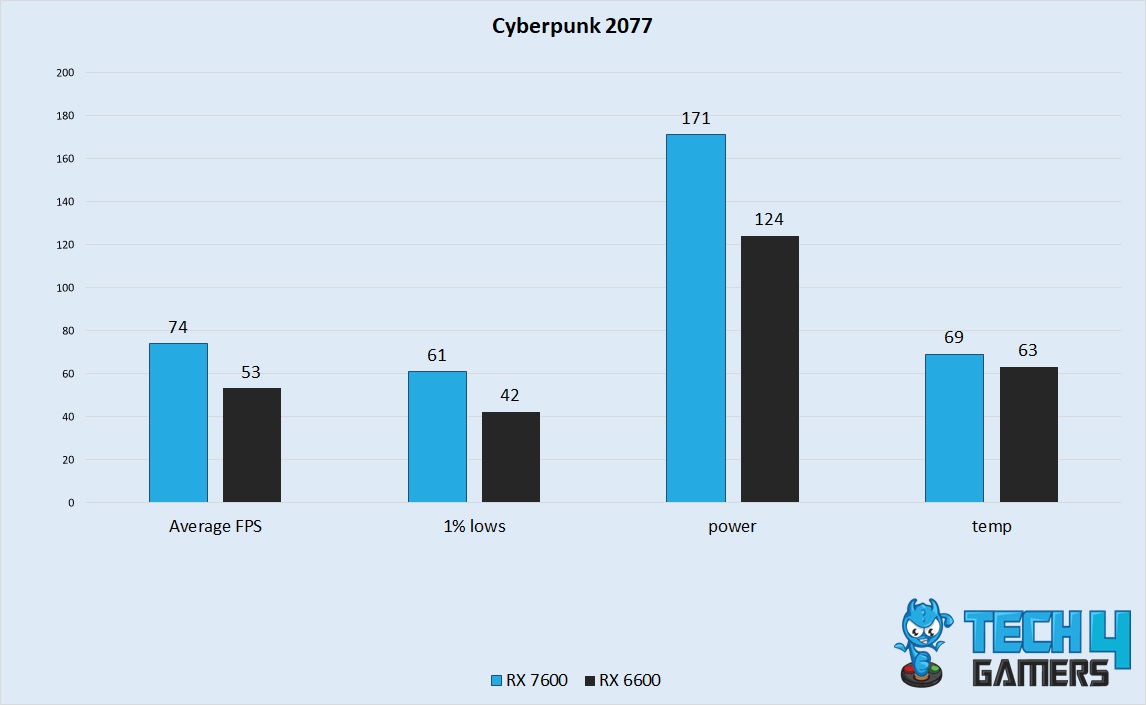
- Our run of Cyberpunk 2077 showed these cards to run this game much better than what we’d expected a few short years ago. The RX 7600 averaged 74 FPS, whereas the RX 6600 averaged 53 FPS.
- 1% lows were better on the RX 7600 at 61 FPS, whereas the RX 6600 had 1% lows of 42 FPS.
- Power consumption was also much different on each card in this game. The 7600 reached a peak power of 171 watts, whereas the RX 6600 had a peak power consumption of 124 watts.
- The RX 7600 peaked at a temperature of 69°C, whereas the RX 6600 was significantly cooler at 63°C.
Also Read: RX 7600 Vs RX 6600 XT
Overall Performance
Framerate
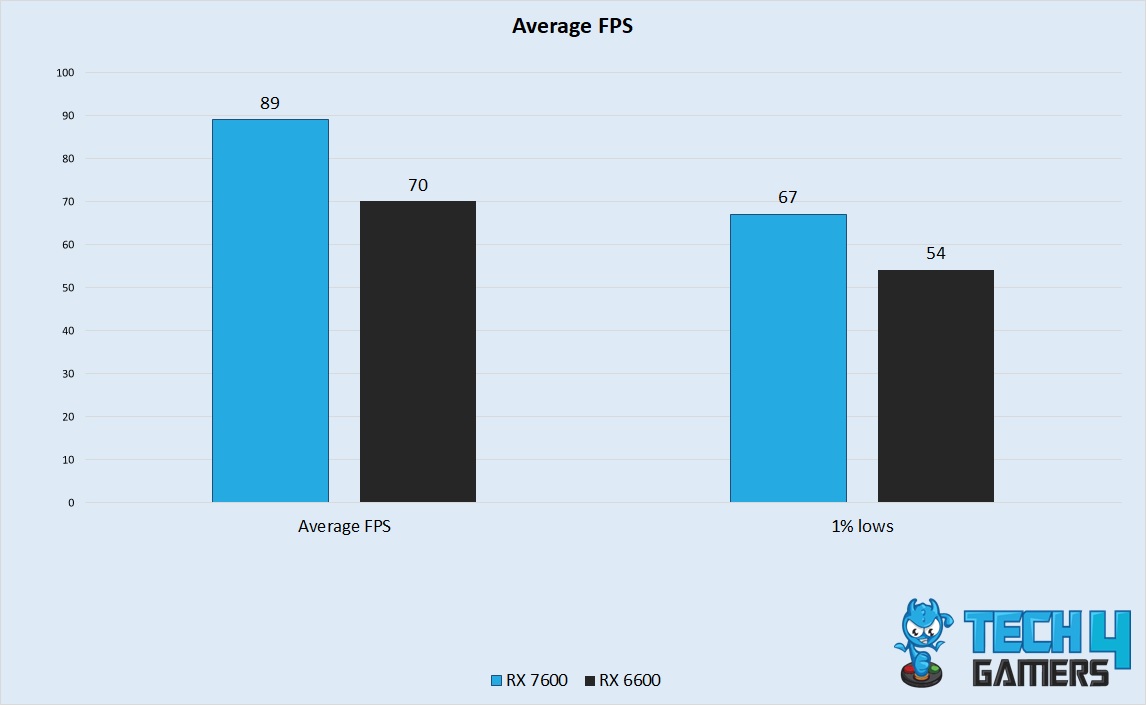
- The RX 7600 had an average framerate of about 89 FPS throughout the nine games tested. It performed about 27% better than the RX 6600, with an average framerate of about 70 FPS.
- As expected, the RX 7600 was also ahead in terms of 1% lows. The 7600 had lows of about 67 FPS on average, whereas the lows on the RX 6600 were about 54 FPS. The difference here was about 23%.
- The difference in performance between these two cards was significant, though much less than expected. The performance jumps of this generation of cards from Nvidia and AMD have not been as drastic as the last-gen jumps. Taking that into account, the difference in performance is an acceptable improvement.
If you are interested in getting as much performance out of your graphics card as possible, take a look at our guide on the best GPU overclocking software.
Power
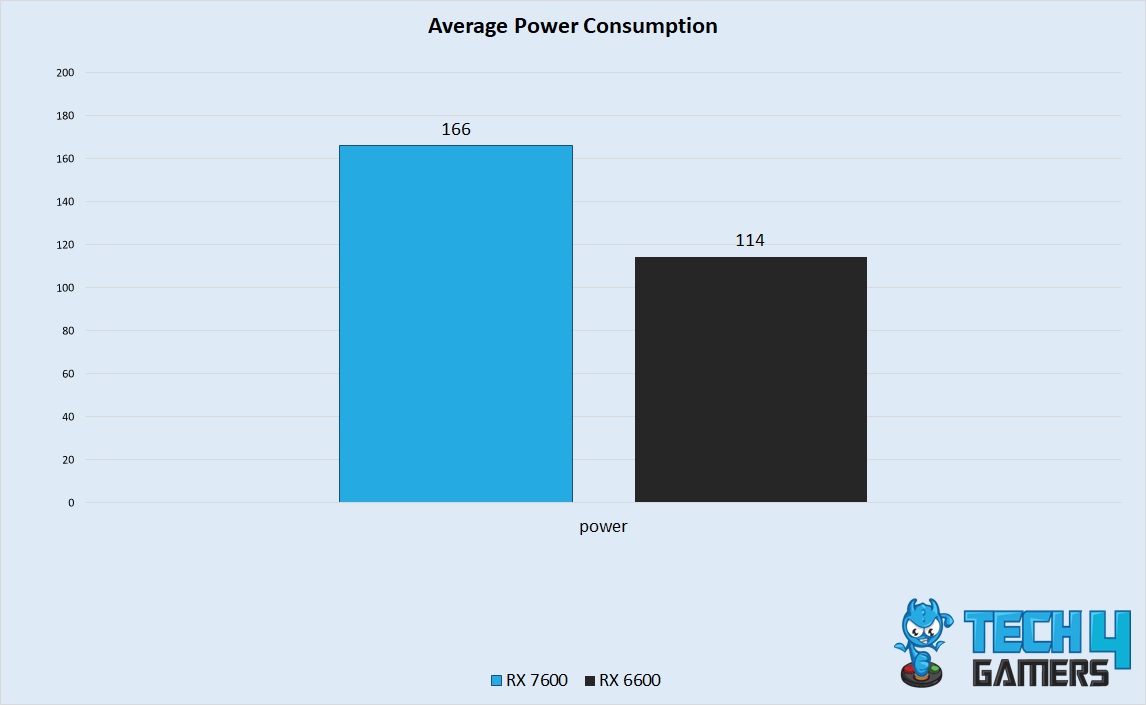
- The RX 7600 proved to be more power-hungry than the RX 6600. It had an average power consumption of 166 watts during our testing, a smidge over its TDP. The RX 6600 had an average power consumption of 114 watts.
- The RX 7600 had about 14% less performance per watt than the RX 6600, which is disappointing for a new product.
To ensure your power supply is sufficient for the power requirements of your entire computer system, we recommend taking a peek at our article that highlights how many watts a gaming PC consumes.
Price And Availability
- The RX 7600 had a launch price is $269, which is notably lower than the RX 6600’s $329 MSRP at launch, representing a refreshing price reduction.
- It’s worth noting that buying the RX 6600 at its original MSRP isn’t advisable due to its age; you can find it on resale websites like eBay for around $150.
- Both cards are relatively recent and should be available in various retail stores, though the older RX 6600, being from a lower tier, might be less common in brick-and-mortar shops. These cards can also be purchased through e-commerce platforms like Amazon.
RX 7600 Vs RX 6600: What We Recommend
- For the newer card, the RX 7600 offers superior performance to the RX 6600 and comes at a lower cost than the 6600’s launch price. It benefits from being newer, ensuring more driver and feature updates. Nevertheless, even without considering these promises, the RX 7600 is a compelling choice for budget-conscious gamers seeking an affordable, up-to-date card for smooth 1080p gaming.
- On the other hand, the RX 6600 has its own advantages. It consumes less power, potentially saving you from needing a higher-wattage power supply unit. Additionally, it’s a more budget-friendly option, especially when purchased in the used market. In summary, we recommend the RX 6600 for gamers operating on a tight budget.
Pros And Cons
| RX 7600 | RX 6600 | ||
| Pros | Cons | Pros | Cons |
| The 7600 will get driver updates for significantly longer than the RX 6600. | It disappoints in the department of power efficiency, consuming more power than its predecessor. | It is a contender to be one of the best price-to-performance card in recent years. | The smaller VRAM capacity on this card can be a limiting factor, adversely affecting your gaming experience. |
| It performs superior to the RX 6600, allowing it to perform better for a few years longer than the RX 6600. | Though better, the performance of the RX 7600 is not a generational improvement compared to its predecessor. | Being a matured card, it is likely that you will never encounter a malfunction of this card that has not been extensively documented already. | The RX 6600 is great at 1080p but is not amazing for 1440p or 4k gaming. |
Frequently Asked Questions
Yes, the 7600 is one of the best deals in the current GPU market.
Using slightly improved manufacturing nodes while increasing clock speeds and core counts leads to more performance and power draw.
AMD says they will release their competitor to DLSS 3 sometime in late 2023.
Thank you! Please share your positive feedback. 🔋
How could we improve this post? Please Help us. 😔
Feedback By:
[Hardware Reviewer]
Hi! I’m Ali Tauseef, and I have been writing for Tech4Gamers since 2022. I love all things computer hardware but am particularly fond of CPUs and motherboards, and I like to stay up-to-date about the latest advancements in these worlds, and when possible, write about it. When I’m not doing that, I like to get into a little FPS action in CS2 or get lost in the vast world of RDR2.
Get In Touch: ali@tech4gamers.com


 Threads
Threads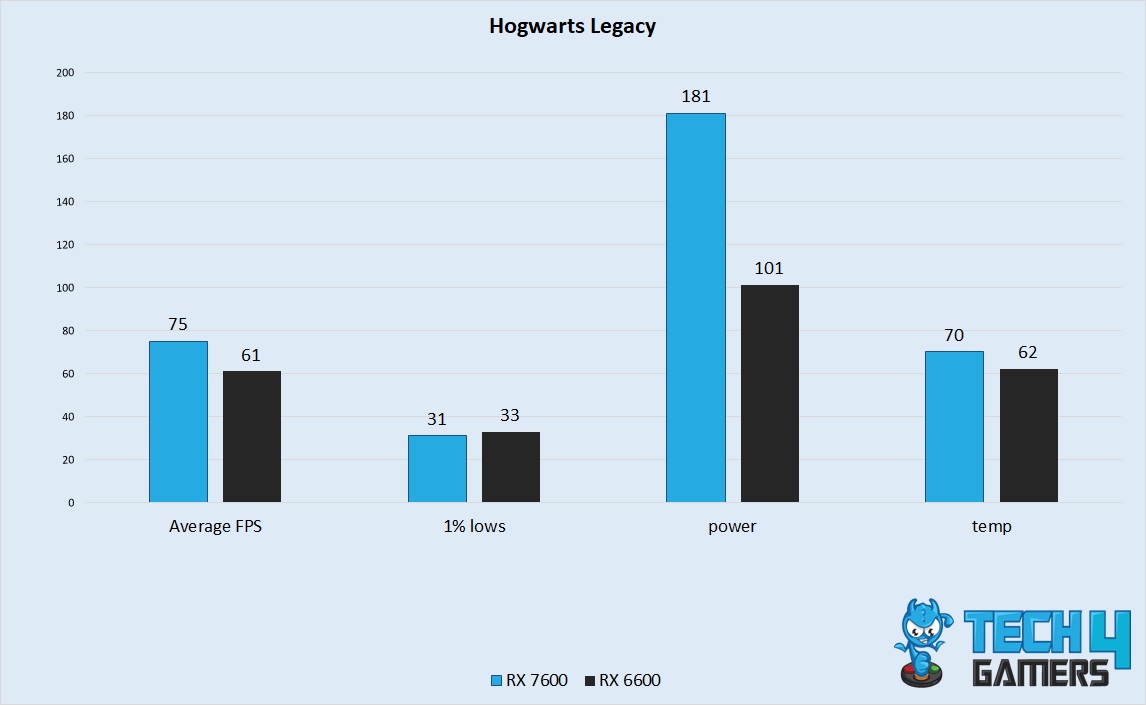
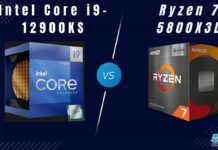
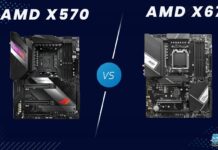
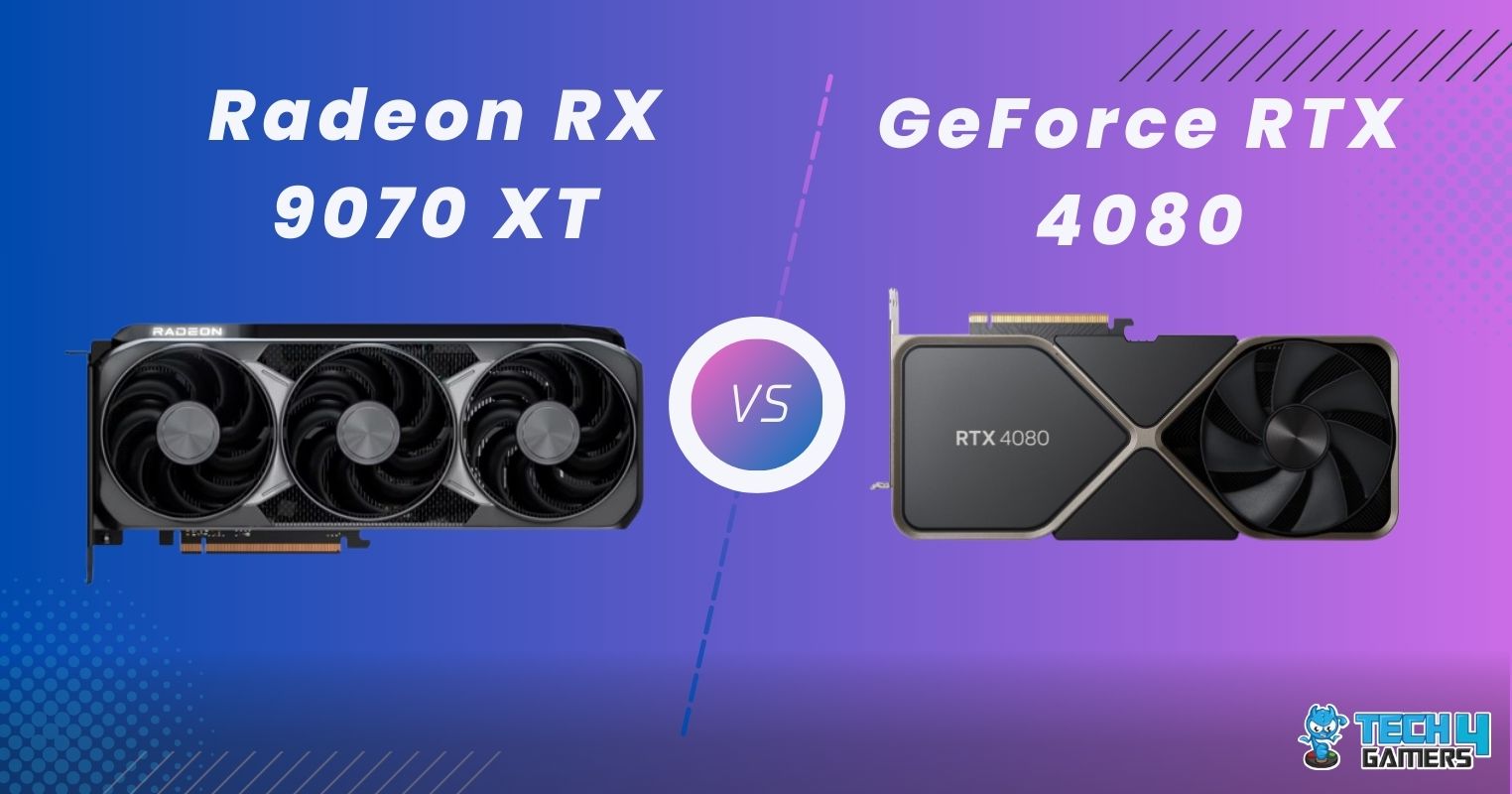
![RTX 4080 Vs RTX 3080 Ti [We Benchmarked Both] Nvidia RTX 4080 Vs. Nvidia RTX 3080 Ti](https://tech4gamers.com/wp-content/uploads/2022/12/Nvidia-RTX-4080-Vs.-Nvidia-RTX-3080-Ti-218x150.jpg)
![Core i5-14600k Vs Ryzen 7 7800X3D [10 Games Tested] core i5 vs 7800x](https://tech4gamers.com/wp-content/uploads/2024/11/core-i5-vs-7800x-218x150.jpg)